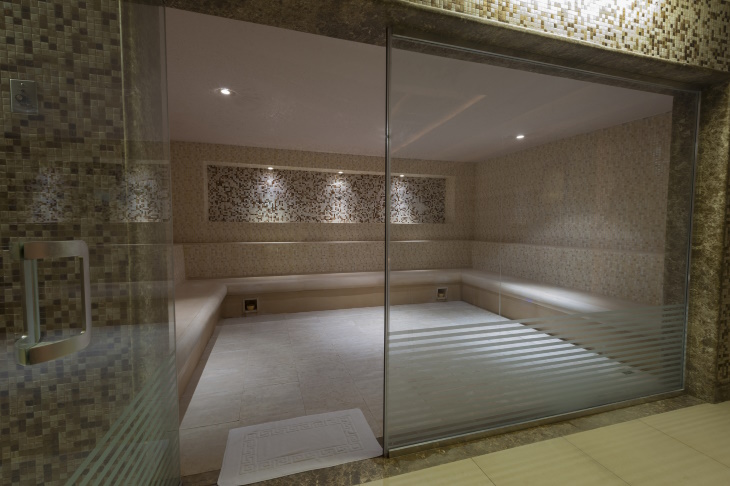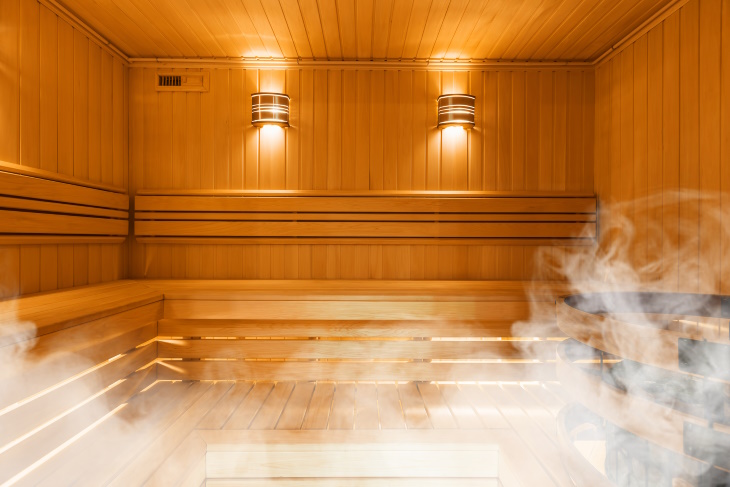Sauna vs Steam Room
Saunas and steam rooms are similar in the sense that both are small heated rooms associated with certain health benefits. The principal difference between the two lies in the type of heat they provide.

The tradition of sauna was invented in Finland thousands of years ago. A sauna is traditionally an enclosed wood-paneled room with rocks heated on a stove. The hot rocks radiate heat, raising the temperature to 160-200°F and keeping the humidity near zero. Much like a desert, a sauna has dry heat. When one pours water onto the rocks, there’s sometimes a small amount of steam, but it evaporates very quickly.
A steam room is also known as a Turkish-style bath. In contrast to saunas, steam rooms are airtight spaces lined with glass, tile, and plastic to seal in moisture. The air in a steam room is heated by a steam generator filled with boiling water, which creates a humid and tropical climate. Compared to a sauna, the temperature in a steam room is never above 100-120°F, but the humidity is kept between 95-100%. Upon entering a steam room, you’ll notice immediately that the humid air is thick and foggy.
The Health Benefits of Sauna
What is a trip to the sauna like?
A traditional sauna provides dry heat. Depending on the sauna you use, you might experience moisture as low as 10% or as high as 60%. The amount of moisture you experience is often dependent on the sauna style you choose. Some saunas allow you to increase the humidity by pouring water on hot rocks to create steam.

The first time you enter a sauna, you’ll notice a rise in body temperature and sweating. The heart rate will increase, the blood vessels will dilate, and you’ll feel blood rushing to your skin. But the skin isn’t the only organ that will experience increased blood flow. The same will happen to all other organs, muscles, and joints. As a result, you may also feel more energized.
Lowers inflammation
A drop in inflammation is the most frequent benefit found in studies. Researchers found that frequent sauna visits lower blood levels of C-reactive protein (CRP), a significant marker of inflammation in the body. Inflammation is a major contributor to chronic diseases like type 2 diabetes, rheumatoid arthritis, high blood pressure, congestive heart failure, and dementia, so this is a major benefit.
The anti-inflammatory effect may be one of the reasons why sauna-goers have a lower risk of many health conditions, concludes one study. Yet another research article states that saunas are particularly beneficial for those whose limitations prevent them from exercising on a regular basis.
All types of heat therapy, be it sauna or steam rooms, provide anti-inflammatory benefits.
Promotes heart health
Any type of heat therapy is beneficial for the cardiovascular system. Research maintains that regular trips to the sauna promote the excretion of hormones that reduce blood pressure and promote heart health. A 2021 study proved that steamy baths for 10-15 minutes are capable of decreasing blood pressure.
Extends lifespan and healthspan
One’s healthspan refers to the number of years lived without serious acute or chronic illness. One research paper stated that frequenting a sauna can delay aging and increase one’s healthspan. The study was conducted on 2,000 men in Finland. The benefits are explained through heat therapy’s ability to improve physical fitness, cardiovascular health, and cognition.
Aids weight loss

Sweating in a sauna won’t help you lose weight right away. This is because any immediate weight loss you may notice after the sauna is due to water loss that you need to replenish by hydrating. However, a trip to the sauna can boost the effectiveness of your diet and exercise routine. Since heat therapy increases one’s heart rate, people frequently go to a sauna or a steam room after a workout as a way to prolong the heart rate elevation they reached during exercise.
Another way in which a sauna can help you boost the benefits of exercise is by relaxing and soothing muscles after a workout.
Stress reduction
One interesting study found that frequent trips to the sauna can reduce the stress level of high-stress occupations (such as doctors and military personnel). They also examined their blood pressure and arterial stiffness and found that 1-2 saunas every week improved both criteria. The researchers concluded that saunas improved participants' stress tolerance and increased their overall health.
Preliminary studies have also made a connection between saunas and a reduced risk of dementia and Alzheimer’s disease, but researchers need more studies to confirm these claims and understand the underlying cause-effect relationship.
Read more on the topic here: 8 Unexpected Health Benefits of Taking a Sauna
The Health Risks of Sauna
High heat can make you feel dizzy or cause you to faint, especially if you’re not used to saunas. That’s why one should never spend more than 10-15 minutes in a sauna. If you stay in a sauna for too long, you may also become dehydrated.
Some people are better off avoiding saunas. In an interview with Verywell Fit, Dr. Adam Rindfleisch states that "people with a high-risk medical history—including kidney disease, liver failure, or cardiac conditions—may not be able to use sauna therapy." Pregnant women are also advised against any form of heat therapy. Saunas can also exacerbate certain skin concerns, such as rosacea, eczema, and atopic dermatitis.
If you have any health conditions or take any medications, check with your doctor before committing to a sauna. “Many medications can make you more sensitive to the heat, so find out what specific precautions you should take,” said Dr. Brunilda Nazario to Huffington Post.
The Health Benefits of Steam Rooms

What does a steam room feel like?
Due to the high humidity, the air in a steam room often feels warmer than in a sauna. Steam concentrates at the top of the room, so if you stand up or raise your hands, you’ll notice that the heat is more intense above. The skin will feel moist to the touch. However, you’ll actually sweat less than you would in a traditional sauna because of the high humidity and lower temperature.
Improves circulation
Attending a steam room improves blood circulation, especially in the legs, according to a study of older adults. That’s because humid heat dilates small blood vessels and improves blood flow around the body, says a 2012 study.
The humid heat also boosts levels of aldosterone, a compound naturally present in the body that lowers blood pressure. If repeated frequently, this can reduce one’s risk of heart disease and causes you to relax.
Promotes skin health
If you’ve ever been to a steam room, you know that it makes the skin feel soft, plump, refreshed, and hydrated right away. It’s just like using a facial steamer, but for your entire body. Humid heat may even help repair damaged skin faster.
Relieves sore joints and muscles
Studies show that steam rooms are superior to saunas for relieving muscle pain after a workout. The humid heat of a steam room is also effective at warming and loosening stiff and achy joints – says the Arthritis Foundation. A fascinating study that measured joint flexibility found that steam rooms can render joints significantly less stiff and more relaxed.
So, if you have any form of arthritis, a steam room is a better choice than a sauna. Using a steam room to prepare the joints for exercise can also reduce the risk of injury.
Unclogs a stuffy nose and sinuses
Sitting in a steam room can immediately relieve the symptoms of a cold, such as nasal congestion, headaches, and a sore throat, and helps you take deeper breaths. The humid heat warms the mucous membranes in the nose, throat, and lungs. You can even combine the benefits of a steam room and eucalyptus or peppermint oil. In fact, many steam rooms diffuse essential oils for that specific reason.
One study even found that steam therapy can improve drainage from the sinuses and improve chronic sinusitis, especially when combined with yoga.
Related article: Is It Possible to Sweat Out a Fever or Cold?
Stress relief
A few minutes in a foggy steam room can seriously make all your stress melt away. The action of taking deep breaths and focusing on bodily sensations essentially sends you into a state of meditation. Hence, you’ll emerge refreshed and clear-minded. There’s evidence that relaxing in steam leads to the release of endorphins, the ‘feel good’ hormones.
The Health Risks of Steam Rooms
Just like saunas, steam rooms can make you feel lightheaded or dehydrated. Hence, it’s recommended that you spend no more than 20 minutes in a steam room, and hydrate both before and after.
The risk of overheating is slightly higher in a steam room because of the high humidity. Sweat doesn’t have the opportunity to evaporate and cool you down efficiently, which can increase your body temperature. This is also why people who already have a fever should avoid a steam room.

Steam rooms can potentially host some germs. People can pick up fungal infections and such in a steam room, so always wear a towel and flip-flops while using a steam room. It’s also recommended to take a shower after use.
Due to the high humidity and heat, steam rooms should be avoided by those who take antibiotics, stimulants, and those who drank alcohol. Pregnant people, persons with epilepsy, and those with heart conditions of any kind are also not advised to use steam rooms.
As you can see, saunas and steam rooms are comparable in terms of their health benefits. For many people, it all boils down to accessibility and personal preference. No matter which you choose, please take another minute to read the tips for using the sauna or steam room below. These tips will help you stay safe and achieve the best results while using either kind of heat therapy.
How to Use a Sauna or Steam Room

Both sauna and steam room visits provide the most benefits when used frequently. In the research articles reviewed for this article, the scientists reported that participants exhibited the most significant results when they used a sauna or steam room at least 1-3 times per week and up to 7 times per week.
If you exercise regularly, we recommend heading to the sauna or steam room after a workout. “Heat overall is good to use after a workout when you have sore muscles,” said Dr. Barbara Bawer to Huffington Post. “Both can help to alleviate soreness and relax muscle by getting more blood flow to the muscles and joints and therefore more oxygen and nutrients to help with recovery,” she continued.
You can also go to a steam room before you exercise as a way to boost flexibility, or even do both consecutively.
Follow these tips before trying a sauna or steam session:
1. Drink plenty of water.
2. Keep each session short – 10-15 minutes for beginners and 15-20 minutes when your body gets accustomed to the heat.
3. Take a shower after each session and apply body lotion right away.
4. Consult your doctor before trying a sauna or steam room, since it’s not suitable if you have some health conditions.
References: Healthline, Medical News Today, Verywell Fit, Huffington Post
 Go to BabaMail
Go to BabaMail































































